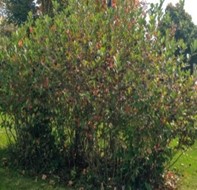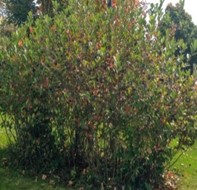Area
The original homeland of blackberry is in eastern North America. It is an introducible plant in Uzbekistan
Botanical description of the plant
Black-fruited Aronia is a 3-meter-tall and strongly branched shrub that usually grows from 0.5 m to 2 m, and in some cases up to 4 m, in its natural range (Eastern, North America). At a young age, the twigs are compact, compressed, and then grow, reaching a diameter of 1.5 to 2 meters. The annual branches are reddish-dark and then turn black-gray. The leaves are simple, whole and oval in shape, 4-8 cm long and 3-5 cm wide. Leaf surface layer thick, fleshy, light, dark green; The underside - white, covered with spots and is less hairy. The flowers are small and bisexual, five-petalled, white or slightly pale red, thyroid, densely located in the inflorescence 5–6 cm in diameter. Blooms from May to June. Flowering period lasts 12-16 days. The fruits ripen in August-September. Fruits are round, sometimes rough, circular, dark or dark red in color, 6–8 mm in diameter, sour - sweet taste. The weight of one fruit is 0.6-1.5 grams. The fruits of cultivated varieties are larger.

Medicinal properties
The fruit contains 10% sugar (mainly glucose and fructose) and alcohol sorbitol, which gives the food a sweet taste and has the property of significantly reducing the amount of sugar in people with diabetes. The fruits of the plant are rich in vitamin R (it has been found that it can reach an average of 2000 mg% or even 6500 mg%). The fruits of the Aronia plant contain carotene (provitamin A), vitamins B, RR, E, C. The average content of anthocyanin pigments in the fruit is 6.4%.
The composition of the fruit of the Aronia plant is rich in micronutrients, with which it is radically different from other plants. Its fruits contain fluorine, iodine compound (6–10 mg per 100 g of pure fruit), iron, copper, manganese, molybdenum compounds. The overall alkalinity of the fruit is 1.3% lower than that of the apple. In addition to the pectin and flavorings that give the fruit a sour taste, it also contains a glycoside amegdalin.
Growing technology
Less demanding to soil conditions. It bears good fruit even in poor soils. Shade-resistant, but in such conditions the yield is significantly reduced. If the American aronia is moderately resistant to cold climates, the cultivated aronia plant is very resistant to winter cold with -35-40o C. Seeds are propagated mainly by stratification. Propagated vegetatively in Uzbekistan by cuttings. It was found that from the middle and upper parts of the annual branch will be strong rooting of cuttings prepared during the period of stunted growth. When cuttings are planted in film greenhouses covered with a light-colored cloth sheltered from the sun, when the greenhouses are equipped with a mist-forming device that periodically sprays, heterouxin (beta-indole acetic acid) -IUK, alpha-petroleum acetic acid - NUK, beta-indole oil acid - When treated with growth agents such as IMK, the vascular intake of cuttings increases.





